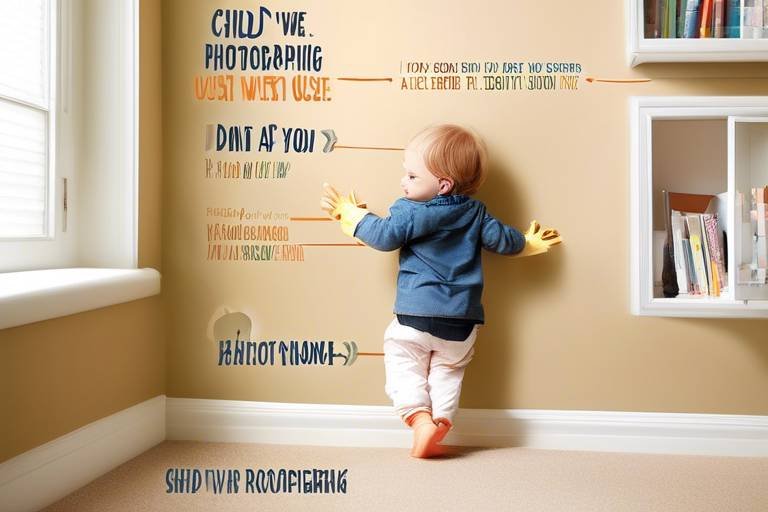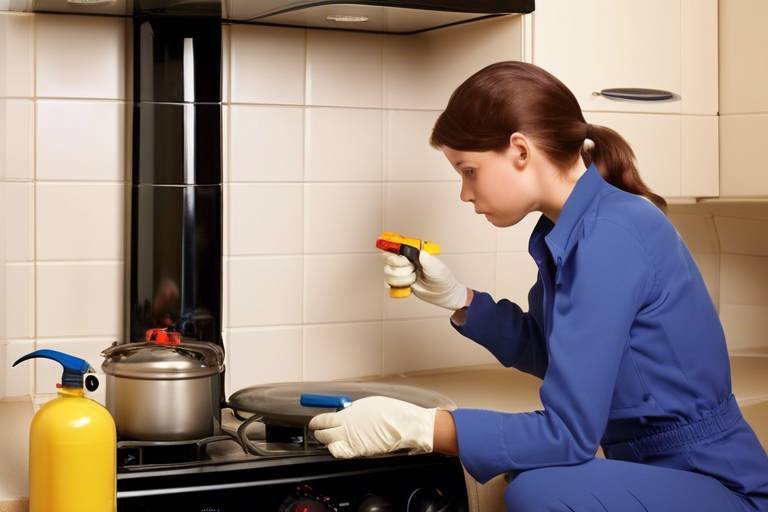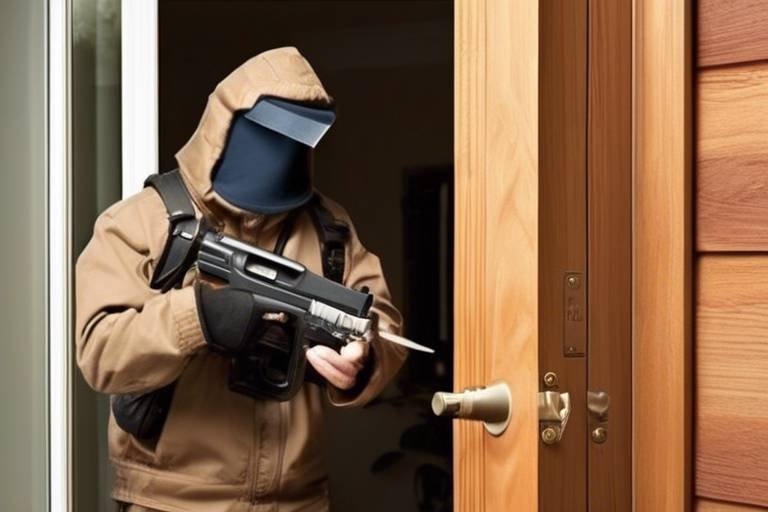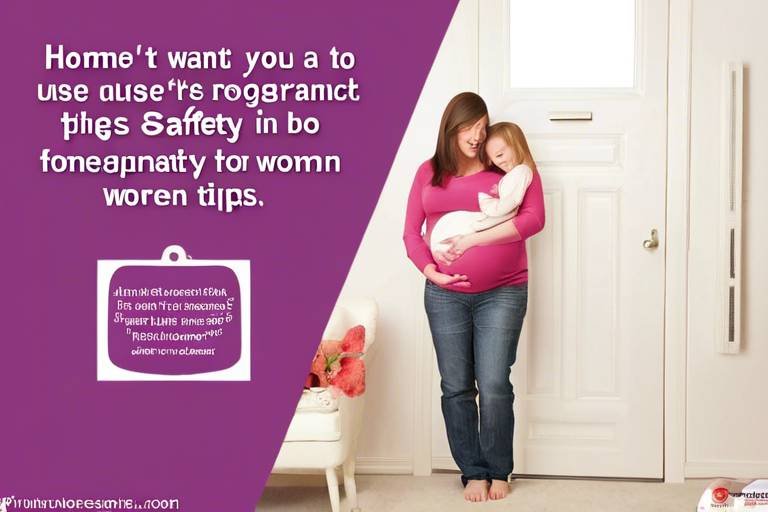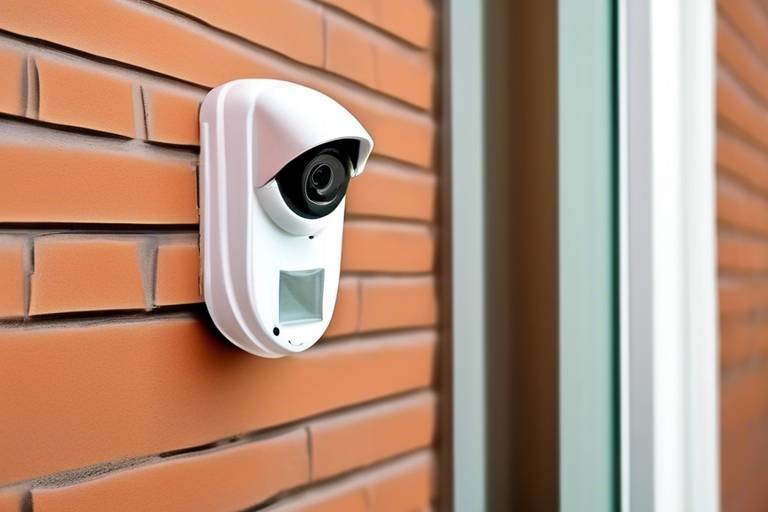Child-Proofing Your Home - A Comprehensive Guide
When it comes to creating a safe environment for our little ones, child-proofing your home is not just a task; it's a necessity. Children are naturally curious, and their adventurous spirits often lead them into situations that can result in accidents and injuries. With the right strategies and products, you can significantly reduce the risks and create a secure haven for your kids. In this comprehensive guide, we’ll explore essential tips and strategies for making your home safe for children, covering various areas that require attention to prevent accidents and injuries.
Identifying common hazards in the home is crucial for effective child-proofing. Children face numerous potential dangers, from sharp edges and toxic substances to electrical outlets and stairs. It's vital to recognize these risks early on, as children are often unaware of the dangers around them. For instance, did you know that over 2.5 million children are treated in emergency rooms for injuries related to falls each year? This statistic alone should make you reconsider how you view safety in your home. By being proactive and assessing your living space, you can pinpoint areas that need immediate attention.
A variety of products can enhance home safety for children. These items are designed to address specific risks and make your home a safer place. Some of the must-have items include safety gates, outlet covers, and corner protectors. Investing in these products not only gives you peace of mind but also protects your little ones from potential hazards. For example, safety gates can effectively restrict access to dangerous areas, while outlet covers prevent electrical accidents. Let's dive deeper into some of these essential products.
Safety gates are vital for restricting access to dangerous areas, such as stairways or rooms that contain hazardous materials. When selecting a safety gate, consider the size and layout of your home. You want a gate that fits snugly and is tall enough to deter even the most determined climbers. In terms of installation, it’s important to follow the manufacturer's instructions carefully to ensure the gate is secure. A poorly installed gate can give a false sense of security and potentially lead to accidents.
There are several types of safety gates available, each designed for specific uses. The most common types are pressure-mounted and hardware-mounted gates. Pressure-mounted gates are easy to install and can be moved around, making them ideal for temporary use. However, they may not be suitable for the top of stairs. On the other hand, hardware-mounted gates are more permanent and provide added security, making them perfect for high-risk areas. Understanding the differences between these types can help you choose the right gate for your home.
Proper installation is key to the effectiveness of safety gates. Here’s a quick guide on how to install a safety gate securely:
- Choose the right location for installation, ensuring the gate fits the opening.
- Use a level to ensure the gate is straight.
- Follow the manufacturer's instructions for mounting, whether using pressure or hardware.
- Test the gate by pushing against it to ensure it is secure.
By following these steps, you can ensure that your safety gate will do its job effectively.
Outlet covers and safety caps are essential for preventing electrical accidents. Children are naturally curious and may try to stick their fingers or objects into outlets, which can lead to severe injuries. By installing outlet covers, you can easily block access to these potential hazards. Additionally, using safety caps on unused outlets adds an extra layer of protection. These simple yet effective products can make a significant difference in keeping your home safe.
A thorough checklist can help ensure every room is safe. Each area of your home presents unique challenges, and having a detailed guide can make the child-proofing process less overwhelming. For instance, the living room may require securing heavy furniture to the wall, while the kitchen needs careful storage of sharp objects and cleaning supplies. By addressing each room systematically, you’ll ensure that no corner is left unprotected.
The living room is often the heart of the home, where families gather for playtime and relaxation. To ensure this space is safe, consider the following measures:
- Secure heavy furniture to the wall to prevent tipping.
- Use corner protectors on sharp furniture edges.
- Keep small objects out of reach to prevent choking hazards.
The kitchen poses unique risks for children, from hot surfaces to sharp knives. To make this area safer, consider implementing the following strategies:
- Store knives and sharp utensils in locked drawers or cabinets.
- Use stove knob covers to prevent accidental activation.
- Keep cleaning supplies in high cabinets or locked storage.
In this section, we address some of the most common questions parents have about child-proofing their homes:
- What age should I start child-proofing my home? It's best to start as soon as your child begins to crawl or walk.
- Are safety gates necessary for all homes? If you have stairs or areas with potential hazards, safety gates are highly recommended.
- How often should I reassess my child-proofing measures? Regularly reassess your home as your child grows and their abilities change.

Understanding Child Safety Risks
When it comes to child-proofing your home, understanding the potential safety risks is the first step in creating a secure environment for your little ones. Children are naturally curious, and their exploratory nature can lead them into dangerous situations without any warning. It's essential to recognize these risks early on to prevent accidents and injuries. Did you know that most household accidents occur in the home? That's right! From slips and falls to choking hazards, the risks are everywhere.
One of the most common hazards in the home is sharp objects. Knives, scissors, and even broken glass can pose significant threats to children who are just learning to navigate their surroundings. It's crucial to keep these items out of reach and stored securely. Additionally, the kitchen is often a hotspot for accidents, with hot surfaces, boiling liquids, and electrical appliances all presenting dangers. Consider how you can make this area safer by implementing some smart storage solutions.
Another significant risk comes from toxic substances. Many household cleaners, medications, and even certain plants can be harmful if ingested. It's vital to keep these items locked away and out of reach, ideally in cabinets with child-proof locks. You might be surprised to learn that even common items like laundry detergent pods can be incredibly dangerous if children get their hands on them. Always read labels and follow safety instructions to minimize these risks.
Moreover, furniture and fixtures can also be a source of danger. Heavy furniture can tip over if not secured properly, and sharp corners on tables can lead to painful injuries. Investing in corner protectors and anchoring furniture to the wall can significantly reduce these risks. It's all about creating a safe space where your child can explore without fear.
In addition to these risks, there are also electrical hazards to consider. Open outlets, exposed cords, and electrical appliances can be particularly enticing for young children. Using outlet covers and ensuring that cords are tucked away can prevent accidents. Remember, just because something seems harmless to an adult doesn't mean it is safe for a child.
To summarize, being aware of these common safety risks is the first step in safeguarding your home. Here’s a quick recap of the key areas to focus on:
- Sharp objects
- Toxic substances
- Furniture and fixtures
- Electrical hazards
By recognizing these potential dangers, you can take proactive steps to child-proof your home effectively. Remember, a little vigilance goes a long way in keeping your child safe. So, are you ready to dive deeper into the world of child-proofing and make your home a safer place?

Essential Child-Proofing Products
When it comes to making your home safe for children, investing in the right child-proofing products is essential. These products act as your first line of defense against potential hazards lurking in your home. From safety gates to outlet covers, each item plays a critical role in ensuring that your little ones can explore their environment without unnecessary risks. Imagine your home as a fortress where every corner is designed to keep your children safe while allowing them the freedom to play and learn.
One of the most important aspects of child-proofing is understanding which products are necessary for your specific living situation. For instance, if you have stairs, safety gates are non-negotiable. They act as a barrier, preventing curious toddlers from tumbling down. Similarly, outlet covers are vital for keeping tiny fingers away from electrical outlets, which can pose serious risks. It's like putting a lock on a treasure chest; you want to keep the valuable things safe!
Additionally, investing in corner protectors can significantly reduce the risk of injuries from sharp furniture edges, especially in active play areas. These soft, cushioned protectors are easy to install and can be a lifesaver. You wouldn't want your child to experience a painful bump when a simple product could have made a difference. Think of child-proofing as creating a safe bubble around your child, allowing them to explore while minimizing the chances of accidents.
To give you a clearer picture, here’s a quick overview of some essential child-proofing products:
| Product | Purpose | Best Use Area |
|---|---|---|
| Safety Gates | Restrict access to stairs and hazardous areas | Stairs, doorways |
| Outlet Covers | Prevent electrical accidents | Living rooms, bedrooms, kitchens |
| Corner Protectors | Reduce injury from sharp furniture edges | Living rooms, dining areas |
| Cabinet Locks | Secure hazardous materials | Kitchens, bathrooms |
Each product serves a distinct purpose, and together, they create a comprehensive safety net for your home. But remember, simply purchasing these products isn't enough. Proper installation and regular checks are crucial to ensure they remain effective over time. You wouldn't want to find out that a gate wasn't secured properly when your child is testing its limits!
In conclusion, child-proofing your home is not just about buying products; it's about understanding the risks and taking proactive measures to mitigate them. By investing in essential child-proofing products, you can create a safer environment for your children, allowing them to thrive and explore without fear. So, what are you waiting for? Start transforming your home into a safe haven for your little explorers today!

Safety Gates
When it comes to ensuring the safety of your little ones, are indispensable tools that can help you create a secure environment in your home. These gates act as a barrier, preventing children from accessing potentially dangerous areas such as staircases, kitchens, or rooms with hazardous items. But with so many options available, how do you choose the right one for your home? It’s essential to consider factors like the gate's material, height, and the specific area where it will be used.
First and foremost, you’ll want to think about the location of the gate. For instance, if you need a gate for the top of the stairs, you’ll want one that is specifically designed for that purpose, as it must be more secure to prevent accidental falls. On the other hand, if you’re blocking off a hallway, a pressure-mounted gate might suffice. Remember, not all gates are created equal; some are more suitable for certain locations than others.
Now, let’s dive into the types of safety gates available on the market. Generally, there are two main types: pressure-mounted and hardware-mounted gates. Pressure-mounted gates are easy to install and remove, making them a popular choice for temporary use. However, they may not be as sturdy as hardware-mounted gates, which are bolted directly into the wall and provide a more secure barrier. If you’re looking for long-term safety, especially in high-risk areas, hardware-mounted gates are often the better choice.
To help you visualize the differences, here’s a quick comparison:
| Type of Gate | Installation Method | Best Used For |
|---|---|---|
| Pressure-Mounted | Easy to install; no tools required | Hallways, doorways |
| Hardware-Mounted | Requires tools; bolted into the wall | Top of stairs, high-traffic areas |
Once you’ve selected the right type of gate, it’s time to focus on the installation process. Proper installation is crucial; a poorly installed gate can easily become ineffective. Here’s a simple guide to ensure you get it right:
- Measure the opening: Before purchasing, measure the width of the area where the gate will be installed.
- Follow the instructions: Each gate comes with its own installation guidelines. Make sure to read them thoroughly.
- Use the right tools: For hardware-mounted gates, you’ll typically need a drill and screwdriver.
- Test the gate: Once installed, push and pull on the gate to ensure it’s secure and won’t budge when your child leans against it.
In conclusion, safety gates are a critical component in child-proofing your home. By understanding the types of gates available and following proper installation techniques, you can create a safer space for your children to explore. Remember, as your child grows, their curiosity will lead them to new adventures, so it’s essential to keep safety gates in mind as part of your ongoing child-proofing efforts.
1. What age should I start using safety gates?
It's recommended to use safety gates as soon as your child begins to crawl, typically around 6 to 10 months old. This will help prevent access to stairs and other hazardous areas.
2. Can I use a pressure-mounted gate at the top of the stairs?
No, pressure-mounted gates are not recommended for the top of stairs. Instead, opt for a hardware-mounted gate for added security.
3. How do I know if a safety gate is sturdy enough?
Look for gates that meet safety standards and have a solid construction. Always test the gate by pushing against it to ensure it doesn’t wobble.

Types of Safety Gates
When it comes to child-proofing your home, choosing the right type of safety gate is essential. These gates are not just barriers; they serve as a **first line of defense** against potential hazards. There are primarily two types of safety gates: pressure-mounted gates and hardware-mounted gates. Each type has its own unique features and ideal applications, making it important to understand the differences.
Pressure-mounted gates are designed to fit snugly between walls or doorways without the need for drilling. They use rubber or foam padding to create friction, which keeps the gate in place. This makes them a popular choice for temporary setups, especially in homes where walls shouldn't be damaged. However, they are best suited for areas where there is no significant pressure or force involved, such as between rooms or at the bottom of stairs. It's crucial to note that these gates are not recommended for the top of stairs due to safety concerns.
On the other hand, hardware-mounted gates require screws for installation, providing a more secure fit. These gates are ideal for high-traffic areas and can withstand more force, making them perfect for the top of stairs or areas where children may push against them. The installation process involves drilling into the wall, which might seem daunting, but it ensures that the gate remains firmly in place, offering peace of mind for parents.
To help you decide which type of safety gate is best for your home, here’s a quick comparison:
| Feature | Pressure-Mounted Gates | Hardware-Mounted Gates |
|---|---|---|
| Installation | Easy, no tools required | Requires tools, more effort needed |
| Location | Between rooms, not suitable for stairs | Top of stairs, high-traffic areas |
| Durability | Less durable, can be pushed over | More durable, can withstand force |
| Damage to Walls | No damage | May require drilling |
When selecting a safety gate, consider where it will be installed and your child’s age and activity level. If you have a particularly active toddler who loves to explore, a hardware-mounted gate might be your best bet. Conversely, if you’re looking for a temporary solution, a pressure-mounted gate could be just the thing.
Ultimately, the right safety gate can provide you with **peace of mind**, knowing that your little one is safe while they explore their environment. Always remember to regularly check the stability of the gate and ensure that it is properly installed, as safety is an ongoing commitment.

Installation Tips
When it comes to installing safety gates, the process might seem straightforward, but there are several important factors to consider to ensure that the gate is both effective and safe. First, you need to determine the best location for the gate. Ideally, it should be placed at the top and bottom of stairs or in doorways that lead to hazardous areas. Before you begin the installation, measure the width of the opening where the gate will be installed. This measurement is crucial because it helps you choose a gate that fits perfectly, preventing any gaps where a child could squeeze through.
Next, consider the type of gate you are using. If you opt for a pressure-mounted gate, it’s essential to ensure that it is securely fitted against the walls or door frames. These gates are easy to install and remove, making them a popular choice for temporary use. However, they may not be suitable for the top of stairs, where a hardware-mounted gate is a safer option. Hardware-mounted gates are bolted to the wall, providing a more secure fit, which is especially important in high-traffic areas.
Once you've selected the right gate, follow these basic installation steps:
- Gather Your Tools: You will typically need a drill, a screwdriver, and a measuring tape.
- Mark the Placement: Use a pencil to mark where the gate will be installed. Make sure to follow the manufacturer’s instructions for height and positioning.
- Install the Gate: For pressure-mounted gates, adjust the tension until it fits snugly. For hardware-mounted gates, drill the holes and attach the gate using the provided screws.
- Test the Gate: After installation, test the gate by pushing against it to ensure it is secure and cannot be easily knocked over by a child.
Lastly, remember that regular maintenance is key. Periodically check the gate to ensure that all screws are tight and that the gate is functioning properly. A gate that is not installed correctly can be a safety hazard, so it’s worth taking the time to do it right. And don’t forget, as your child grows, you’ll want to adjust or remove gates as necessary. Keeping your home safe is an ongoing process, and being proactive about safety measures can make all the difference.
Q: How do I know which type of safety gate to choose?
A: The choice between pressure-mounted and hardware-mounted gates depends on where you plan to install them. Pressure-mounted gates are great for doorways, while hardware-mounted gates are recommended for the top of stairs.
Q: Can I install a safety gate myself?
A: Yes! Most safety gates come with installation instructions that are easy to follow. Just make sure you have the right tools and take your time to ensure a secure fit.
Q: How often should I check the safety gate?
A: It's a good idea to check the gate regularly, at least once a month, to make sure it’s secure and functioning properly. Look for any signs of wear and tear.

Outlet Covers and Safety Caps
When it comes to child-proofing your home, outlet covers and safety caps are non-negotiable essentials. These small yet mighty devices play a crucial role in preventing electrical accidents, which can be serious and sometimes fatal. Children are naturally curious, and their little fingers can easily find their way into electrical outlets, leading to dangerous situations. Thus, ensuring that every outlet is covered is a vital step in creating a safe environment for your little explorers.
Outlet covers are designed to fit snugly into standard electrical outlets, making it nearly impossible for children to access the live parts inside. These covers typically come in two types: permanent covers, which are installed by an electrician and require tools to remove, and plug-in covers, which are removable and can be easily replaced. While both types provide a level of safety, permanent covers offer the highest protection, especially in homes with particularly curious toddlers.
Safety caps, on the other hand, are another layer of protection. They are inserted into unused outlets, effectively blocking any access. It’s important to note that while these caps are a great addition, they should not be relied upon solely. Regular checks are necessary to ensure that they are not removed or lost, as children can sometimes figure out how to take them out. Therefore, it’s best to combine both outlet covers and safety caps for comprehensive protection.
Here’s a quick comparison of outlet covers and safety caps:
| Feature | Outlet Covers | Safety Caps |
|---|---|---|
| Installation | Requires tools for permanent covers | Easy to insert and remove |
| Level of Protection | High (especially permanent covers) | Moderate (best for unused outlets) |
| Recommended Age | All ages, especially toddlers | Best for toddlers and young children |
In addition to using outlet covers and safety caps, educate older children about the dangers of electricity. Encourage them to never insert objects into outlets or tamper with electrical devices. Setting clear rules around electrical safety can significantly reduce risks. Remember, child-proofing your home is not just about installing products; it’s also about fostering a culture of safety and awareness within your family.
Finally, regularly inspect all outlet covers and safety caps for wear and tear. If any are damaged or missing, replace them immediately to maintain a safe environment. After all, in the world of child-proofing, an ounce of prevention is worth a pound of cure!

Room-by-Room Child-Proofing Checklist
When it comes to child-proofing your home, a systematic approach is essential. Each room in your house presents unique challenges, and understanding these can significantly reduce the risk of accidents. Think of your home as a playground for your little ones, and just like any playground, it needs to be safe and secure. Let’s dive into a room-by-room checklist that will help you transform your home into a child-friendly haven.
Starting with the living room, this space often serves as the family gathering point. It’s crucial to ensure that furniture is arranged to prevent any tripping hazards. Large items like coffee tables should be placed away from high-traffic areas. Additionally, consider securing heavy furniture to the wall to prevent tipping. It’s also wise to keep fragile items, such as vases and picture frames, out of reach. A great tip is to use storage solutions like baskets or bins to keep toys organized and off the floor, reducing clutter and potential hazards.
Moving on to the kitchen, this area is notorious for its potential dangers. Hot surfaces, sharp utensils, and toxic substances can pose significant risks to curious little hands. Start by installing safety latches on cabinets that contain cleaning supplies or sharp objects. It’s also important to keep hot pots and pans on the back burner and use stove knob covers to prevent accidental activation. A child-proofing tip that many parents overlook is the placement of small appliances; make sure they are stored safely away when not in use, and consider using appliance locks for those that are frequently used.
Next, let’s talk about the bathroom. This room requires special attention due to its slippery surfaces and the presence of potentially harmful items like medications and cleaning products. Always keep medications in a locked cabinet or high shelf, and use non-slip mats in the tub and on the floor to prevent slips and falls. It’s also a good idea to install a toilet lock to prevent drowning accidents. Lastly, keep electrical appliances like hairdryers and razors out of reach and unplugged when not in use.
In the bedroom, safety revolves around ensuring a secure sleeping environment. Use cribs that meet current safety standards, and ensure that bedding is appropriate for the child’s age. Remove any items from the crib that could pose a suffocation risk, such as pillows or stuffed animals. It’s also important to keep dressers and tall furniture secured to the wall to prevent tipping. If your child is old enough for a bed, consider using bed rails to prevent falls during sleep.
Finally, don’t forget about the outdoor areas. Whether you have a backyard or a balcony, ensuring safety outside is just as important as inside. Install fencing around pools and ensure that gates are self-closing and self-latching. Keep tools and gardening supplies locked away, and regularly inspect play equipment for wear and tear. If you have a garden, be mindful of any toxic plants that could be harmful if ingested.
By following this room-by-room checklist, you can take proactive steps to create a safer environment for your children. Remember, child-proofing is not a one-time task but an ongoing process as your child grows and explores new things. Always stay vigilant and ready to adapt your safety measures as needed.
Q: How often should I child-proof my home?
A: It’s recommended to reassess your home’s safety every few months, especially as your child grows and develops new skills.
Q: Are there specific child-proofing products I should prioritize?
A: Yes, focus on securing heavy furniture, using safety gates, outlet covers, and cabinet locks as your top priorities.
Q: What should I do if I have older children and a newborn?
A: Ensure that older children understand safety rules and keep small toys or items that could be choking hazards out of reach of the newborn.
Q: Can I child-proof my home on my own, or should I hire a professional?
A: Many child-proofing measures can be done by parents, but consulting a professional can provide peace of mind, especially for complex installations.

Living Room Safety
The living room is often considered the heart of the home, where families gather to relax, play, and share moments together. However, it can also be a hotspot for potential hazards, especially for curious little ones. To ensure your living room is a safe haven, it’s essential to identify and mitigate risks that could lead to accidents. One of the first things to consider is the arrangement of furniture. Sharp corners on coffee tables or low furniture can pose a threat. To combat this, you might want to invest in corner protectors that cushion those sharp edges, making them less dangerous for toddlers who are just learning to walk or run.
Another important aspect of living room safety is keeping heavy items secured. Bookshelves, televisions, and other large furniture pieces should be anchored to the wall to prevent tipping. Did you know that a child can pull down a bookshelf in a matter of seconds? It’s a startling thought, but one that can be easily remedied with the right anchors. Additionally, consider the placement of cords from electronics. These can be tempting for little hands to tug on, leading to potential injuries. Use cord organizers or covers to keep these out of reach, ensuring that your living room remains a safe space.
Moreover, you should be mindful of the toys and play items scattered around. While it’s great for children to have access to their toys, it’s crucial to keep the living room organized. A cluttered space can lead to tripping hazards, especially if your little one is zooming around. Establishing a designated play area and using storage solutions like baskets or bins can help maintain order. This way, not only do you keep the space tidy, but you also teach your kids the importance of cleaning up after themselves.
Lastly, let's not forget the importance of supervision. While child-proofing your living room is essential, nothing beats keeping an eye on your children as they explore their environment. Engaging with them during playtime not only enhances their learning but also allows you to intervene quickly if a risky situation arises. Remember, the goal is not to create a sterile environment but to foster a space where your children can play freely while staying safe.
Q: What are some common hazards in the living room?
A: Common hazards include sharp furniture edges, heavy items that can tip over, and loose cords from electronics.
Q: How can I secure my furniture to prevent tipping?
A: Use wall anchors or brackets to secure heavy furniture like bookshelves and televisions to the wall.
Q: Should I remove all toys from the living room?
A: No, it's important to have a designated play area. Just ensure toys are organized to avoid clutter and tripping hazards.
Q: How can I keep cords out of reach?
A: Use cord organizers or covers to keep electrical cords secured and out of your child's reach.

Kitchen Precautions
The kitchen is often seen as the heart of the home, where delicious meals are prepared and family memories are made. However, it can also be a dangerous place for little ones who are naturally curious and eager to explore. To create a safe environment, it's essential to implement effective that minimize risks and keep your children out of harm's way. By being proactive, you can transform your kitchen from a potential hazard zone into a safe haven.
One of the first steps in ensuring kitchen safety is to evaluate the layout and accessibility of items within reach of children. For instance, sharp knives and other utensils should always be stored in high cabinets or locked drawers. You might think, "What’s the big deal? I can just keep an eye on them!" But kids are quick, and a moment’s distraction can lead to accidents. To avoid this, consider using a child-proof latch on drawers and cabinets that contain dangerous items.
Next, let’s talk about appliances. Many kitchen appliances can pose serious risks if not properly managed. Always keep the stove and oven knobs out of reach, or use knob covers to prevent little hands from turning them on. It’s also wise to use the back burners whenever possible, and to turn pot handles inward to avoid accidental spills. Imagine a hot pot tipping over—yikes! That's a nightmare scenario we want to avoid at all costs!
Another vital area to focus on is the storage of cleaning supplies. Many common household cleaners contain toxic substances that can be harmful if ingested. Store these items in a locked cabinet or high shelf, and always ensure that they are clearly labeled. If you have guests over, remind them to keep their bags out of reach as well, as they might inadvertently leave harmful items accessible to curious hands.
Additionally, it’s important to teach your children about kitchen safety from an early age. While child-proofing your kitchen is essential, instilling a sense of caution in your kids will go a long way. Start with simple lessons, like explaining why certain items are off-limits and the importance of asking for help when they want to participate in cooking or baking. This approach not only keeps them safe but also makes them feel included in the family activities.
In summary, creating a safe kitchen environment requires a combination of physical child-proofing measures and educational practices. By taking the necessary precautions and engaging your children in safety discussions, you’re not just protecting them from immediate dangers but also teaching them to be responsible in the kitchen as they grow. Remember, safety is not just about preventing accidents; it’s about fostering a sense of security that allows your family to enjoy the heart of your home without fear.
- What are the most common kitchen hazards for children?
Common hazards include sharp utensils, hot surfaces, and toxic cleaning supplies. Always keep these items out of reach.
- How can I involve my children in cooking safely?
Start with simple tasks that are age-appropriate, and always supervise them closely. Teach them about safety as they help.
- Are there specific child-proofing products I should consider?
Yes! Look for cabinet locks, stove knob covers, and safety latches to enhance kitchen safety.
Frequently Asked Questions
- What are the common hazards in a home for children?
Common hazards include sharp objects, electrical outlets, stairs, and toxic substances. It's essential to identify these risks early to prevent accidents. Regularly inspect your home for potential dangers, especially in areas where children play or explore.
- How can I child-proof my living room effectively?
To child-proof your living room, start by securing furniture to the walls to prevent tipping. Use corner protectors on sharp edges, and ensure that any small items or choking hazards are out of reach. Additionally, consider using safety gates to restrict access to areas that may pose a risk.
- Are safety gates necessary for all homes with children?
While not every home may require safety gates, they are highly recommended for homes with stairs or rooms that contain potential hazards. Safety gates can provide a crucial barrier, helping to keep children safe from dangerous areas.
- What types of safety gates are available?
There are two main types of safety gates: pressure-mounted and hardware-mounted. Pressure-mounted gates are easy to install and remove, making them ideal for temporary use. Hardware-mounted gates are more secure and are best for top of stairs or permanent installations.
- How do I install a safety gate properly?
To install a safety gate, first measure the opening where you plan to place it. Follow the manufacturer's instructions closely, ensuring that the gate is securely mounted. Double-check that it opens and closes smoothly and that there are no gaps where a child could slip through.
- Why are outlet covers important?
Outlet covers are important because they prevent children from inserting objects into electrical outlets, which can lead to severe electrical shocks. Using outlet covers is a simple yet effective way to enhance safety in your home.
- What should I keep in mind while child-proofing the kitchen?
In the kitchen, store sharp utensils, cleaning supplies, and medications out of reach. Use appliance locks on ovens and dishwashers, and consider installing safety latches on cabinets. Always supervise children when they are in the kitchen to prevent accidents.
- How often should I reassess the safety of my home?
It's a good idea to reassess your home's safety regularly, especially as your child grows and their abilities change. What was safe for a toddler may not be safe for a curious toddler learning to climb or explore. Regular checks ensure that your home remains a safe environment.

